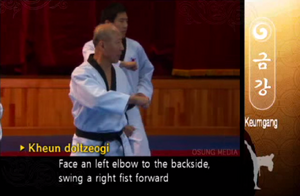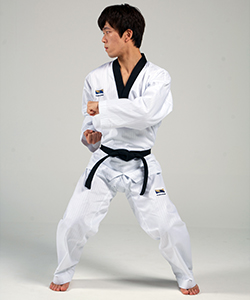No edit summary |
(Adding categories) |
||
| (11 intermediate revisions by one other user not shown) | |||
| Line 1: | Line 1: | ||
| + | [[Image:Keumgang_LargeHingeBlock.png|right|thumb|300px|Here a Large Hinge Block is being used to chamber for an upcoming movement in the form Keumgang.]] |
||
| − | A '''Hinge Block''' is a |
+ | A '''Hinge Block''' is a preparatory position in which: |
| − | *The non-blocking fist is pulled to the waist, just as it would be for a punch |
||
| − | *The blocking |
+ | * The non-blocking fist is pulled to the waist, just as it would be for a punch |
| + | * The blocking arm is held in front of the body |
||
| ⚫ | |||
| + | The Hinge Block (also called simply Hinge) is usually used as a preparatory position (i.e., it is used for [[Chamber|chambering]]). In Karate, a Hinge Block is called a '''Teacup''' or ''koshi gamae;'' one will sometimes see the word Teacup used in Taekwondo as well. |
||
| − | For a ''' |
+ | For a '''Small Hinge Block''' (''jageun dolzteogi''), the blocking fist is held just above the non-blocking fist, so that the blocking forearm is held across the lower belly. The blocking fist is held with the palm facing backward, so that the back of the hand is toward the opponent. The Small Hinge Block appears, for example, in the form [[Taebaek]]. |
| ⚫ | For a '''Large Hinge Block''' (''kheun dolzteogi'') the blocking fist is held just away from the non-blocking pectoral, so that the blocking forearm is held horizontally across the chest, about two fist-widths away from the chest. The blocking fist is held palm-down, so that the back of the hand is toward the sky. The Large Hinge Block appears, for example, in the form [[Keumgang]]. |
||
| − | [[File:Hinge_Block.jpg|left|frame|Hinge Block]] |
||
| − | [[Image: |
+ | [[Image:Hinge_Block.jpg|left|frame|Hinge Block]] |
| − | |||
| − | {{Whiteline}} |
||
[[Category:Block]] |
[[Category:Block]] |
||
| + | [[Category:Site administration]] |
||
Latest revision as of 05:03, 23 May 2020

Here a Large Hinge Block is being used to chamber for an upcoming movement in the form Keumgang.
A Hinge Block is a preparatory position in which:
- The non-blocking fist is pulled to the waist, just as it would be for a punch
- The blocking arm is held in front of the body
The Hinge Block (also called simply Hinge) is usually used as a preparatory position (i.e., it is used for chambering). In Karate, a Hinge Block is called a Teacup or koshi gamae; one will sometimes see the word Teacup used in Taekwondo as well.
For a Small Hinge Block (jageun dolzteogi), the blocking fist is held just above the non-blocking fist, so that the blocking forearm is held across the lower belly. The blocking fist is held with the palm facing backward, so that the back of the hand is toward the opponent. The Small Hinge Block appears, for example, in the form Taebaek.
For a Large Hinge Block (kheun dolzteogi) the blocking fist is held just away from the non-blocking pectoral, so that the blocking forearm is held horizontally across the chest, about two fist-widths away from the chest. The blocking fist is held palm-down, so that the back of the hand is toward the sky. The Large Hinge Block appears, for example, in the form Keumgang.

Hinge Block